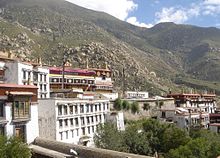Drepung
| Drepung Monastery | |
|---|---|

Drepung Monastery
|
|
| Tibetan transcription(s) | |
| Tibetan | འབྲས་སྤུངས་ |
| Wylie transliteration | ’bras spungs |
| Pronunciation in IPA | [[tʂɛpuŋ]] |
| Official transcription (China) | Zhaibung |
| THL | Drepung |
| Other transcriptions | Dräpung, Drebung |
| Chinese transcription(s) | |
| Traditional | 哲蚌寺 |
| Simplified | 哲蚌寺 |
| Pinyin | Zhébàng Sì |
|
|
|
| Coordinates | 29°40′35″N 91°2′51″E / 29.67639°N 91.04750°E |
| Monastery information | |
| Location | Mount Gephel, Lhasa, Tibet, China |
| Founded by | Jamyang Chojey |
| Founded | 1416 |
| Type | Tibetan Buddhist |
| Sect | Gelug |
| Dedicated to | Je Tsongkhapa |
| Colleges | 7 - Gomang, Loseling, Deyang, Shagkor, Gyelwa or Tosamling, Dulwa and Ngagpa |
Drepung Monastery (Wylie: 'bras spungs dgon pa), (literally “Rice Heap” monastery), located at the foot of Mount Gephel, is one of the "great three" Gelukpa university monasteries of Tibet. The other two are Ganden and Sera.
Drepung is the largest of all Tibetan monasteries and is located on the Gambo Utse mountain, five kilometers from the western suburb of Lhasa.
Freddie Spencer Chapman reported, after his 1936-37 trip to Tibet, that Drepung was at that time the largest monastery in the world, and housed 7,700 monks, "but sometimes as many as 10,000 monks."
Since the 1950s, Drepung Monastery, along with its peers Ganden and Sera, have lost much of their independence and spiritual credibility in the eyes of Tibetans since they operate under the close watch of the Chinese security services. All three were reestablished in exile in the 1950s in Karnataka state in south India. Drepung and Ganden are in Mundgod and Sera is in Bylakuppe.
It was founded in 1416 by Jamyang Choge Tashi Palden (1397–1449), one of Tsongkhapa's main disciples, and it was named after the sacred abode in South India of Shridhanyakataka. Drepung was the principal seat of the Gelugpa school and it retained the premier place amongst the four great Gelugpa monasteries. The Ganden Podang (dga´ ldan pho brang) in Drepung was the residence of the Dalai Lamas until the Great Fifth Dalai Lama constructed the Potala. Drepung was known for the high standards of its academic study, and was called the Nalanda of Tibet, a reference to the great Buddhist monastic university of India.
Old records show that there were two centres of power in Drepung: the so-called lower chamber (Zimkhang 'og ma) associated with the Dalai Lamas-to-be, and the upper chamber (Zimkhang gong ma) associated with the descendants of Sonam Drakpa, an illustrious teacher who died in 1554. The estate of the Dalai Lamas at Drepung Monastery, called Ganden Phodrang, had been constructed in 1518 by Gendun Gyatso Palzangpo (1476–1541), retrospectively named and counted as 2nd Dalai Lama. The name of the Tibetan regime or government established by the 5th Dalai Lama came from the name of this estate.
...
Wikipedia

